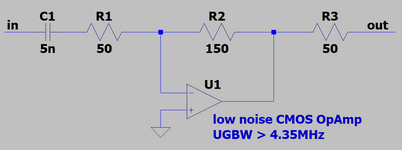Minchuu
Junior Member level 1
Hello,
I was searching through CMOS LNA designs and I found this in GitHub and I think it's perfect for my application except for the frequency. For this, I will need a frequency range of 0.65MHz to 1.45 MHz instead of the 2.4 GHz in the original design.
Can you guys point out the inductors and capacitors I will need to change in the schematic and what is the equation I will need to use to compute for the new values in order to have 0.65 to 1.45 MHz frequency?
Thanks in advance.

I was searching through CMOS LNA designs and I found this in GitHub and I think it's perfect for my application except for the frequency. For this, I will need a frequency range of 0.65MHz to 1.45 MHz instead of the 2.4 GHz in the original design.
Can you guys point out the inductors and capacitors I will need to change in the schematic and what is the equation I will need to use to compute for the new values in order to have 0.65 to 1.45 MHz frequency?
Thanks in advance.
